Australia So Much to See


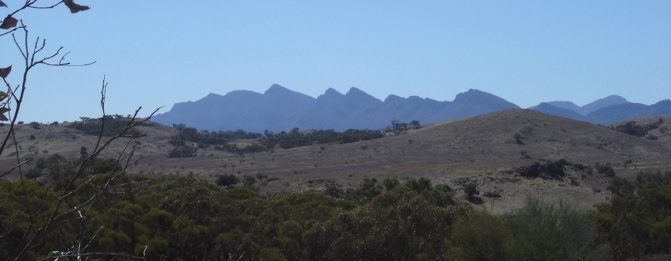
Part way between Pimba and Glendambo, the towbar on the Patrol broke with a bang, and the caravan dragged on the safety chains as
we pulled to a stop onto the narrow edge of the road. I drove back to Wirraminna station which we had passed. The family
farm 1,600 sheep and 800 cattle as well as running an accommodation business. They had guests arriving as well as getting ready
for shearing, but they took the time to make phone call after phone call to endeavour to find someone who could repair our tow hitch
so we could continue. It was Saturday afternoon and annual race day at Roxby Downs and most people were not at home. He
eventually found help for us at Glendambo. Glendambo is also not much more than a fuel station and motel, with only a few houses
and wonderful outback people.
It was dark when I got back to the caravan, so we moved on for only a short distance until we could
pull of the road with safety. Apart from trucks rattling across a nearby grid, it was a peaceful enough spot. We do not
like to drive at night in pastoral areas.
We were warned that the road from Glendambo to Kingoonya was badly corrugated
due to mining exploration trucks. But this was not the worst part of that day’s drive.
We crossed the east-west
railway line at Kingoonya. This former railway service point now appeared to be an Aboriginal settlement.
In all, it was
290 kilometres from Glendambo to Wirrulla, all but the last twenty kilometres was rather badly corrugated. The route runs
between the salt Lakes Everard and Gairdner.
The orange land and hills along the northern half of the route were distinctive.
We
stopped along the Nullarbor Bunda Cliffs this time at a lower section, accessed by an informal track, where walking down to a tiny
beach would have been easy.
Heading towards Balladonia, we drove towards showers. The sunset indicated more rain
to come. Lightning danced in the east and south east all night.
As we drove through Balladonia in the morning, rain was
coming in from the south. It poured all the way to Norseman. How often we have met rain at Balladonia or Norseman. We turned off to try our normal way home through the
Our last night on the road
was spent in bush between
We left home on 25 January, departed
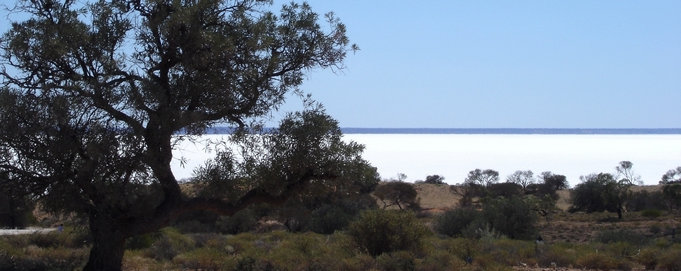
Looking towards Wilpena Pound late in the afternoon from the Cazneauz Tree.
This tree was photographed by Harold Cazneaux in
1937, and he won many awards for his photo entitled ‘The Spirit of Endurance’. The tree looks similar today, with even more
green branches, showing its true endurance.
At
Moving further north, we drove through the interesting Brachina Gorge geological trail, where a huge variety
of geological formations and fossils are well signed. The road follows and criss-crosses the creek line.
Our plan
was to stay overnight in the Gorge, but with rain settling in, we feared we may be trapped if the creek rose. As we moved out
of the Gorge to flat plains, rain was rapidly closing in and obscuring Wilpena Pound and surrounding ranges.
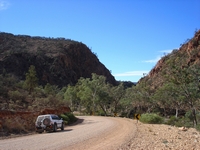
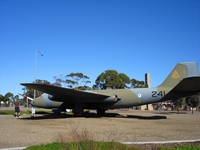
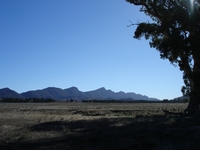
A taste of the Outback.
As we were on our way home, our tour was brief and did not cover many of the drives and sights
of the Northern Flinders and the south Australian Outback.
Leaving our wonderful hosts at
We diverged from the Highway
to head north towards the northern
Update: The Flinders Range National Park was renamed Ikara-Flinders Ranges National Park on 12th February 2016 in recognition of the Aboriginal name for this ancient groups of ranges.
Dragon
lizards seen on the walk to Arkaroo Rock, an important Aboriginal art site in the
Approaching the southern rim of the Wilpena Pound.
Looking across the floor
from the peak Mount Ohlssen Bagge
The view north from the peak, with distant ranges in pastel shades, and the flower stalk of
the Yakka, which grows all through the ranges. We started the trek early in the day, and found the breeze at the top refreshing. Others from a tourist coach with international tourists were heading up as we descended, and a few ladies had to stop.
Overlooking
the Wilpena Pound resort. There is a large dam which supplies all water to the resort complex, and the largest solar power station
in
The view from the top of the rim.
Climbing
down again. The trek involved some scrambling.
We did not do the walk to the highest peak on the pound, St Mary’s
Peak. This trail incorporates an optional loop across the floor of the pound which takes all day.
The old station
homestead not far is inside the opening to the pound where to creek drains out. Station owners grazed sheep and cattle, and
grew wheat in the pound, which they cleared. They had to cut through a huge rock to enable wagons to fit through the entrance
to market the wool. The station did not prove viable in adverse seasons.
A healthy black buck watched us from beside
a permanent water hole along the Wilpena Creek.
In the
Looking back on the track we had just
come down.
Leaving the
We pulled of the road at a blue metal dump in this very flat area, although occasional low ranges
dot the distance, as can be seen silhouetted against the setting sun.
The Ochre Cliffs near Lyndhurst have pigments of
shades orange, and was used by Aboriginals for ceremonial purposes, as well as in medicine, art and trading.
Further to
the north, the now ghost town of
It was also the most northern point
where wheat and barley was grown. This proved unsuccessful as wet years are rare. Here sheep head for a dam on the station. There is very little vegetation.
Marree is a small outback town with much of interest. It is at the start of the Birdsville and the Oodnadatta tracks, and was on the former Ghan railway line. The Ghan line now goes further to the west. See more at Marree from our 2019 tour.
Tom
Kruze’s original mail truck used on the Birdsville mail run.
On the wall of the information centre, a map shows how artesian
water is being taken from points north and east of Marree to Roxby Downs mines. This is endangering natural wetlands and wild
life.
“If the transnationals and colonist governments continue to defy the natural order of things in their quest for
material wealth, Mother Earth will retaliate, the whole environment will retaliate, and the abusers will be eliminated. Things
will come back full circle back to where they started. This is the prophecy of all indigenous peoples” (1981)
We left Marree,
heading out onto the Oodnadatta Track, which we followed for around 70 kilometres. Two young people on pushbikes were
heading north along this track.
Some remnants of some of the former railway sidings remain.
At Alberrie Creek, the
overhead water tank has been made to look like a dog. See more at Alberrie Creek 2019.
We turned south to go follow the Borefield
Track. This road services the pipeline from the bore fields north of Marree taking water to Roxby Downs mines.
The
Borefield Track was in good conditions, although only a few days earlier, rain has made it so slippery it was virtually impassable.
From Roxby Downs, where the BHP (formerly WMC) mine is one of the
largest copper mines in the world and uranium, gold, silver and other minerals are also mined, we visited the opal mining settlement
of Andamooka.
Andamooka is a settlement of shanties amongst diggings – with the appearance of a gold mining town of the
gold rush era.
Heading towards Woomera, much of the way is through a truly treeless and flat area.
At Woomera,
there is an interesting outdoor display of rockets and aeroplanes.
Inside the museum the history of and the reasons for the rocket
range are demonstrated, as well as stories of success and failures in rocket trials.
There is a section dedicated to the memory
of Len Beadell, the surveyor who found and surveyed the
We met the
From the Parachilna Hotel, we drove on to the Parachilna Gorge, stopping along the road near a creek which had already crossed the
road.
We monitored the creek levels during the night. The rain had stopped by the time we went to bed, and the water levels
went slowly down.
Next morning it was sunny, and a magpie warbled in the morning. Feral goats clattered their way
down the rocks from the very tip of the hill behind us.
Further along, we stopped at Blinman, a former copper mining
town, and walked around the old mine site.
A short drive south from Blinman is “The Great China Wall”. Eroded hills
in this area have a ridge of rock protruding along the top.
Heading north east, the vegetation became sparse. We drove
into Chambers Gorge, which is significant aboriginal cultural site. The
The next highlight was Arkaroola; a private conservation park. This former station was purchased in the 1960s by the Reginald and Griselda Sprigg who returned to its natural state and developed
eco-tourism. In the past mining has included gold, copper, uranium and radium. There are a number of self drive tours
and walk trails, as well as a four wheel drive self drive track with a fee to access. Other four wheel drive tracks can only be taken
with staff and flights are offered.
There is an astronomical observatory.
The drive to the Paralana
Hot Springs was one of beauty and interest. The radio-active water seeps to the surface and is too hot to touch; even further
down the creek line it is still very warm.
Well worth visiting Arkaroola for a few days.
Remnants of the cottage
at Lively’s gold find.
Driving through station back tracks east of Arkaroola, across ridges of jagged rocks with scarcely a blade
of grass, we were surprised that we didn’t see any sheep at all.
Then we came to the station homestead and shearing shed. 5,000 sheep were being shorn and were in very good condition; astonishing on the dry bare ground. The station is around 500
or so square miles.
Considering the price of wool, and the high cost of maintaining a remote station, I cannot see how it could
be a viable enterprise.
We also spoke to station owners at the adjoining station, where they run only 4,000 sheep on two
adjoining stations. In an area with and expected annual rainfall of six inches or 100 millimetres which can fall at any time
of year, the last few years the rain fall has varied from none at all to four inches or 150 millimetres. They also have to dig
wells much deeper to reach ground water.